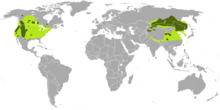
Back Amerikaanse elk Afrikaans إلكة Arabic الالكه ARZ Cervus canadensis AST Karguol (Cervus elaphus canadensis) AVK Kanada maralı Azerbaijani Вапіці Byelorussian Уапити Bulgarian ཤྭ་བ་རྔ་རིང་། Tibetan Wapiti Breton
| Elk Temporal range: Early Pleistocene – Recent
| |
|---|---|

| |
| A bull (male) in Alberta, Canada | |

| |
| A cow (female) with calf in Wyoming, United States | |
| Scientific classification | |
| Domain: | Eukaryota |
| Kingdom: | Animalia |
| Phylum: | Chordata |
| Class: | Mammalia |
| Order: | Artiodactyla |
| Family: | Cervidae |
| Genus: | Cervus |
| Species: | C. canadensis
|
| Binomial name | |
| Cervus canadensis | |
| Subspecies | |

| |
| Reconstructed (light green) and current (dark green) native ranges of Cervus canadensis | |
| Synonyms | |
|
Various Cervus elaphus subspecies | |
The elk (pl.: elk or elks; Cervus canadensis), or wapiti, is the second largest species within the deer family, Cervidae, and one of the largest terrestrial mammals in its native range of North America and Central and East Asia. The word "elk" originally referred to the European variety of the moose, Alces alces, but was transferred to Cervus canadensis by North American colonists.
The name "wapiti" is derived from a Shawnee and Cree word meaning "white rump", after the distinctive light fur around the tail region which the animals may fluff-up or raise to signal their agitation or distress to one another, when fleeing perceived threats, or among males courting females and sparring for dominance. A similar trait is seen in other artiodactyl species, like the bighorn sheep, pronghorn and the white-tailed deer, to varying degrees.
Elk dwell in open forest and forest-edge habitats, grazing on grasses and sedges and browsing higher-growing plants, leaves, twigs and bark. Male elk have large, blood- and nerve-filled antlers, which they routinely shed each year as weather warms-up. Males also engage in ritualized mating behaviors during the mating season, including posturing to attract females, antler-wrestling (sparring), and bugling, a loud series of throaty whistles, bellows, screams, and other vocalizations that establish dominance over other males and aim to attract females.
Elk were long believed to belong to a subspecies of the European red deer (Cervus elaphus), but evidence from many mitochondrial DNA genetic studies, beginning in 1998, shows that the two are distinct species. The elk's wider rump-patch and paler-hued antlers are key morphological differences that distinguish C. canadensis from C. elaphus. Although it is currently only native to North America, Central, East and North Asia, elk once had a much wider distribution in the past; prehistoric populations were present across Eurasia and into Western Europe during the Late Pleistocene, surviving into the early Holocene in Southern Sweden and the Alps. The now-extinct North American Merriam's elk subspecies (Cervus canadensis merriami) once ranged south into Mexico. The wapiti has also successfully adapted to countries outside of its natural range where it has been introduced, including Argentina and New Zealand; the animal's adaptability in these areas may, in fact, be so successful as to threaten the sensitive endemic ecosystems and species it encounters.
As a member of the Artiodactyla order (and distant relative of the Bovidae), elk are susceptible to several infectious diseases which can be transmitted to and/or from domesticated livestock. Efforts to eliminate infectious diseases from elk populations, primarily by vaccination, have had mixed success. Some cultures revere the elk as having spiritual significance. Antlers and velvet are used in traditional medicines in parts of Asia; the production of ground antler and velvet supplements is also a thriving naturopathic industry in several countries, including the United States, China and Canada. The elk is hunted as a game species, and their meat is leaner, and higher in protein, than beef or chicken.
- ^ Brook, S.M.; Pluháček, J.; Lorenzini, R.; Lovari, S.; Masseti, M.; Pereladova, O.; Mattioli, S. (2019) [errata version of 2018 assessment]. "Cervus canadensis". IUCN Red List of Threatened Species. 2018: e.T55997823A142396828. doi:10.2305/IUCN.UK.2018-2.RLTS.T55997823A142396828.en. Retrieved 9 September 2020.
- ^ Erxleben, J.C.P. (1777). Anfangsgründe der Naturlehre and Systema regni animalis. Göttingen.
